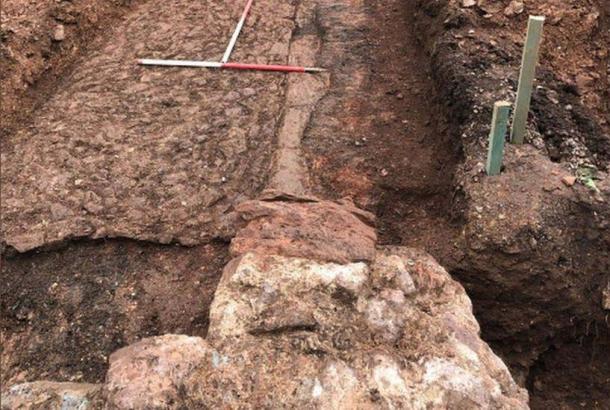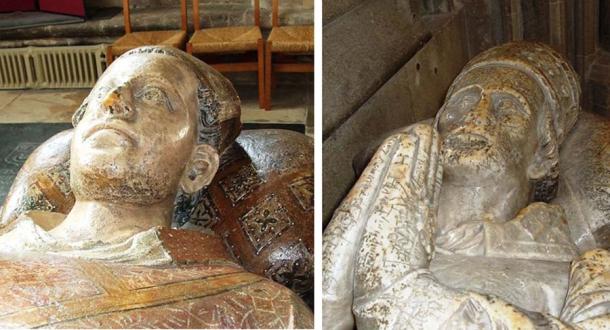An 81-year-old retired banker’s construction plans have been halted by the discovery of a lost bishop’s palace in Wiveliscombe, Somerset, England. While archaeologists have called the Medieval ruins a “significant find”, the surprise has been both exciting and unfortunate for the man.
BBC News reports that the ruins of the bishop’s palace – a Medieval wall and fireplace – were found by the builders working at the retired man’s property in the aptly-named Palace Gardens. The find was made when the man started to build a bungalow so he could move into it and sell his current house.

The ruins are believed to belong to a Medieval bishop’s palace. ( South West Heritage Trust )
The Bishop’s Palace is a Significant (and Expensive) Surprise
Bob Croft, the county archaeologist for the South West Heritage Trust, has called the ruins of the bishop’s palace a “significant find” and said it has “put an important dot on the map of Wiveliscombe, but also on the map of Somerset.” Discovering the bishop’s palace has solved a local mystery.
Researchers had an inkling that the bishop’s palace was somewhere in the area, but they were uncertain of the exact location prior to this find. Croft noted that there was a possibility of discovering the bishop’s palace during this work because “The gateway is still there” however, Croft said
“What we didn’t know is where the buildings would have been in relation to that gateway. They’ve often been thought of as being much further to the east where we knew there was a big barn and a big open space, but this is the first time we’ve actually got stone foundations discovered.”

The Bishop’s Palace and accompanying Bishop’s House at Wells. (David Dixon/ CC BY-SA 2.0 ) In the Middle Ages a Bishop of Bath and Wells would have resided here and also used the Wiveliscombe palace.
According to The Mirror, retired banker Charles Pole “is excited but annoyed” with the discovery, which has held up the construction plans. “I’m pleased they found it, but I’m also not pleased because they’ve held up the build” Pole said, and explained:
“I live on my own in a house in Palace Gardens and I’m disabled. I was having a bungalow built in the garden for myself and plan to sell the house. When the builder saw the remains, he was ordered to stop work. It came as a big surprise. It was exciting to hear the site contains something of real significance, but the cost of the investigation is going to cost me around £15,000 and has delayed the bungalow.”
Who Resided at the Bishop’s Palace 700 Years Ago?
According to BBC News, the bishop’s palace would have been one of several residences for the Bishop of Bath and Wells. Several documents show that two bishops in particular carried out major construction work in Wiveliscombe between 1309-1363. Those bishops were Bishop Drokensford (1309-1329) and Bishop Ralph of Shrewsbury (1329-1363).

The bishop’s palace has been linked to Bishop John Drokensford ( Public Domain ) right, and Ralph of Shrewsbury ( Public Domain ), left.
Somerset Historic Environment Record’s website says that the bishop’s palace was likely built, or rebuilt by John de Drokensford and added to by Ralph of Shrewsbury. It’s said to have been “a favourite retreat of the bishops all through the Middle Ages ” and “Many of the medieval bishops used Wiveliscombe, sometimes for long periods.”
The Bishop’s Palace website mentions that Bishop Ralph of Shrewsbury was authoritarian and not well-liked by parishioners – he made some particularly unpopular choices during the Plague – and “During troubled or dangerous times, he removed himself to his palace in Wiveliscombe, where he felt safe.”
But by the 18th century the Wiveliscombe bishop’s palace was in ruins and there was a workhouse constructed on part of the site in 1735.
What’s Next for the Site and Mr. Pole?
BBC News reports that the archaeological documentation of the site has been completed but the next step in the process is to decide how the foundations will be preserved. A spokesperson for the South West Heritage Trust said, “The remains are a significant find and the landowner, archaeologists, builder and architect are working to protect and record the site. The development is being monitored by archaeologists from the South West Heritage Trust as part of the planning requirements.”
Expectations are that the site will be protected and covered. Then Mr. Pole will be allowed to continue work on his bungalow – with a hefty fee for the archaeological work and an interesting story to tell.
Top Image: Ruins of a bishop’s palace were discovered during construction work in Somerset, England. Source: Somerset County Gazette
By Alicia McDermott
Related posts:
Views: 0
 RSS Feed
RSS Feed

















 March 15th, 2021
March 15th, 2021  Awake Goy
Awake Goy  Posted in
Posted in  Tags:
Tags: 
















